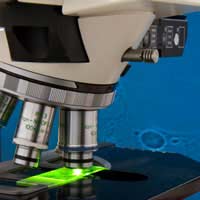All About DNA and Proteins

The relationship between DNA and proteins is one that is vital to sustaining life. You have likely heard the term 'protein' before in the sense of foodstuffs but perhaps have not thought about the role that proteins play inside your body. This role is dependent on DNA. Put simply, DNA codes for proteins. In turn, these proteins have an enormous range of crucial functions in an organism. First, however, you need to understand how genes work before you can get a sense of how DNA and proteins become important to life.
Understanding Genes
If you have already familiarised yourself with the basics of DNA, you will probably know that DNA has a double helix structure. This double helix holds information in a code and parts of DNA hold messages known as genes. These genes are code messages that relay vital information for all of the body's cellular functioning. Genes determine many characteristics and attributes of an organism such as how it metabolises food, fights infections and even behavioural characteristics. It is your genes that regulate protein production. Genes are complex in the sense that they don't simply need a code to tell them how to operate. They also have structural aspects that regulate how they function. This is similar to a switch that turns different functions on and off. A gene will only work in specific cells for a specific duration of time, as well as other regulatory aspects.What is a Protein?
A protein is an abundant and complicated molecule that is found in your body. There are many different types of proteins, including:- Structural proteins
- Messenger proteins
- Enzymes
They play roles such as forming hair and skin or controlling various functions through hormones. Proteins can also increase how quickly a reaction occurs in the body or perform functions such as creating haemoglobin for blood cells.
DNA and its Relationship to Proteins
The route from DNA to proteins can seem like a long and complicated one. It helps if you imagine mailing a letter to someone who lives far away from your home. Rather than hand your friend a letter, think about the realistic process you go through to get that letter delivered. You have to first write the letter itself, and then mail it before it reaches its final destination. This process is actually quite a similar but simplified version of how DNA codes for proteins. The first step that occurs is a process known as transcription, where the important information in the gene is 'written' down on a different molecule. This molecule acts as a messenger to carry the information to other parts of the cell. The cell can then receive the information before a process known as translation comes into play.If you think about that letter again, imagine your friend speaks a different language than you do, which means the letter must be translated before your friend can understand the contents. The same is true for the process of translation that occurs with DNA. Before a cell can actually use the information and follow its instructions, it needs to understand the information. To do this, your cells have something called ribosomes. These ribosomes act as translators by translating the messenger's code into the proper protein format. Once this is done, the protein can be directed to the areas of the cell that require the information or they can be sent around the body.
Ultimately, it is each gene that provides a unique 'letter' of instructions to produce and deliver proteins all around the body. These proteins have a range of special shapes and chemical makeup to allow them to perform the many important and necessary functions that support and maintain an organism.


Re: How was DNA Discovered?
DNA is not a real thing, the earth is flat, the sun is blue
Re: An Overview of DNA Functions
I tried to extract DNA from my refrigerator, now I have no refrigerator and my food is rotting.
Re: The Properties of DNA
what are 5 characteristics of DNA?
Re: How was DNA Discovered?
betty for the last time im trying to sleep bugger of babe
Re: How was DNA Discovered?
It is past you bedtime winnie pleas go to bved now or no france for you go back to easter island looser!!!
Re: How was DNA Discovered?
My bed time is at 9:00 and it is 9.01 in indea at the moment> i am sooooooooo naughty
Re: How was DNA Discovered?
ICE ICE DAVEY
Re: How was DNA Discovered?
This sorkis absalutely propostuous I found out about DNAfirst these loosers lied
Re: How was DNA Discovered?
meow
Re: How was DNA Discovered?
this workis realy interresting i would love to disscus more about this with you